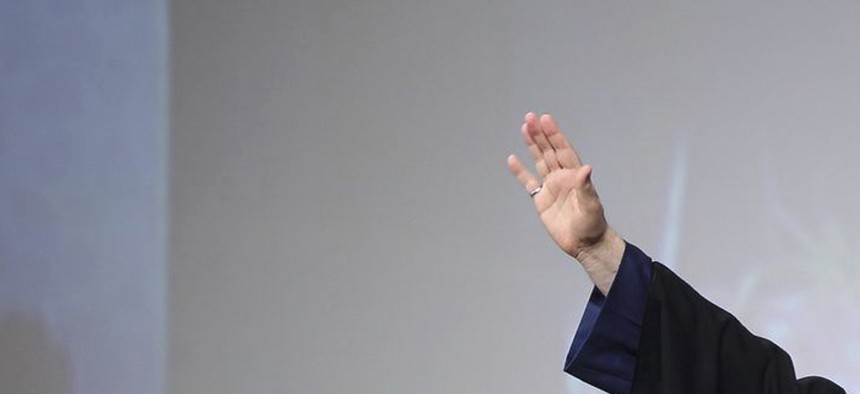
Advocating increased engagement with the foreign world, Iranian President Hassan Rouhani speaks to students at Shahid Beheshti University, Tehran, Iran, Dec. 7, 2013. AP Photo/Iranian Presidency Office, Mohammad Berno
It’s Time to Bring Iran in from the Cold and End Sunni-Shiite Rhetoric
The Geneva nuclear deal with Iran could be the precise thing we need to end the Sunni-Shia rhetoric I grew up with. By Fariborz Ghadar
When the P5+1 world powers struck a deal with Iran to freeze its nuclear program, some worried it will bring Iran in from the cold. Yet, perhaps that’s precisely the change that needs to happen.
When I was young, growing up in Iran, we all considered ourselves Muslims. Although it’s true that technically there were Shiites and Sunnis, the distinction was not adversarial. The Iranian government did not make a distinction, and, when you applied for a visa, you were simply asked your religion. Moreover, Shia Iran worked hand-in-hand with Sunni Saudi Arabia to protect the Middle East from communism’s influence.
But the Iranian Revolution changed everything.
Fearing the United States would try to topple the new regime, the Iranian government defended itself against all Western allies by threatening to export the Revolution. Understandably, this alarmed the royal families in the region, who then used the sectarian divide as a defense mechanism. Therefore, the Sunni-Shiite distinction became beneficial as a response to manage the exportation of the Iranian Revolution. As a result, 30 years later, we now have a distinct, tumultuous Sunni-Shiite divide. Today when you apply for a visa in Saudi Arabia, you must state the sect of Muslim religion to which you belong.
The world and, in particular, Middle Eastern regimes bear responsibility for this schism in the Muslim religion that didn’t previously exist, but now has grown out of proportion and is being used as proxy wars — primarily backed by Saudi Arabia and Iran — in places such as Syria, Iraq and Lebanon. However, if the Iranian regime comes out of the cold because of the Geneva deal, and does not want to export the Revolution and destabilize the royal Sunni regimes, then using the Sunni-Shiite schism is counterproductive.
Because of all that has ensued, it’s obviously going to be extremely difficult to narrow the schism. But, on a couple of occasions, when Iranian Presidents Khadmi and Rafsanjani made rapprochements toward Saudi Arabia, the Sunni-Shiite rhetoric was toned down. This bodes well.
Truthfully, the logical way to stabilize the region is to resolve the schism. Without a resolution, the Middle East will remain a dangerous area for years to come, as conflict continues to fester. As the impending youth bulge reaches maturity, angry, unemployed and often-educated youth are bound to instigate additional conflict, sparking situations similar to the Arab Spring. If the region is left religiously divided, more fuel will consequently be added to their fire.
[Related: Defense One's complete Iran coverage.]
So, let’s see if we can actively attempt to return to the environment in which I grew up — the one in which we all simply identified as Muslim. Based on recent events, there’s no better time than the present. The present Iranian regime has indicated that it once again wants to have a positive rapprochement with Saudi Arabia and the Emirates. In this delicate transition with Iran, it is critical that the United States assures Saudi Arabia and other allies in the region that the U.S. has in no way reduced its commitment to the safety and security of their regimes, as well.
Removing the Sunni-Shiite rhetoric from national security discussions will hopefully provide a stepping-stone for further reconciliation and consequently a more stable region. Ultimately, this would significantly help not only Iran and Saudi Arabia, but also other countries in the region.
Fariborz Ghadar is a senior adviser at the Center for Strategic & International Studies and professor of global management at Penn State. He held a vice ministerial position in the Shah of Iran’s cabinet.




